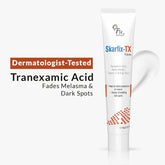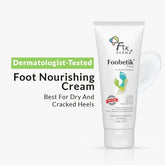Monsoon Footcare 101: Prevent Infections, Peeling Skin & Cracks

Table of Contents
- Monsoon Triggers: What’s Harming Your Feet?
- Recognizing the Signs: When It’s More Than Just Dry Skin
- Expert-Backed Footcare Routine for Monsoon (Dermatologist-Approved)
- Science Says: Why You Need More Than a Regular Moisturizer
- Fixderma to the Rescue: Dermatologist-Recommended Footcare Solutions
- Fixderma’s Monsoon Footcare Regimen (Your 2-Step Routine)
- Final Thoughts: Don’t Let the Rains Ruin Your Soles
- FAQs: Your Monsoon Footcare Questions Answered
- More Blogs For You
With the soothing sound of rain, cooler temperatures, and a breeze, the monsoon brings a feeling of joy for many. But while the season is a rainbow of happiness for your heart, it can be a villain for your skin. Soggy shoes, smelly feet, and surprise cracks on your heels are just part of the many skin concerns this rainy season brings with it.
If you've ever peeled off wet socks only to discover itchy feet, painful foot cracks, or white, flaky skin, you're not alone. The rainy season can silently mess with your foot health, especially if you're someone who walks around in damp footwear, skips moisturizer, or lives with conditions like diabetic foot.
Therefore, your feet need as much care as your face. And in this blog, we're talking about the things you need to know about monsoon foot concerns and how to give your feet the care they deserve.
So, let’s break down why your feet need some extra love during the monsoons and how you can protect them with dermatologist-approved solutions.
Why Monsoon Footcare Deserves Special Attention
Humidity + wet conditions = the perfect environment for bacteria and fungi to thrive. Most of us walk without realising the threat and walk around with damp shoes, moist socks, or even barefoot during the rains.
These habits can lead to issues like:
- Foot cracks
- Fungal infections
- Peeling or itchy skin
- Heel pain
- And for some, the risk of diabetic foot ulcers
People living with diabetes are especially vulnerable. What may seem like a harmless crack on the heel could turn into a slow-healing wound due to poor circulation or nerve damage. That’s why monsoon footcare isn’t just about keeping your feet soft, it’s about preventing serious health issues, with care rooted in science and dermatology.

Monsoon Triggers: What’s Harming Your Feet?
Ever wonder why your heels get worse during rains? Blame these everyday habits:
- Wearing wet shoes or socks or letting the moisture set in your footwear for long.
- Walking barefoot or in puddles, home, or going to the washroom.
- Excess sweat leading to soggy, over-softened skin (a.k.a. skin maceration)
- Neglecting barrier repair creams or foot hygiene
All these habits open the doors to cracked heels, itchy fungal infections, and if left untreated, diabetic foot symptoms like tingling, redness, or slow healing.

Recognizing the Signs: When It’s More Than Just Dry Skin
Monsoon foot problems often start small and are easy to miss. Keep an eye out for:
- Deep heel cracks that feel sore and painful when you walk
- Peeling skin, white spots between toes
- Redness or swelling (signs of bacterial infection)
- Numbness, tingling, or delayed healing—possible signs of early diabetic foot symptoms
If your feet feel uncomfortable, smell funky, or aren’t healing well—don’t ignore it. This is when a dermatologist's guidance can make all the difference.

Expert-Backed Footcare Routine for Monsoon (Dermatologist-Approved)
Taking care of your feet doesn’t need to be complicated. Follow this simple, derm-approved daily routine:
- Cleanse: Use a gentle antifungal or antibacterial
- Dry thoroughly: Especially between the toes and
- Moisturize & repair: Apply a foot crack cream or foot cream for cracked
- Protect: Choose open, breathable footwear and change socks often
Diabetic foot care tips:
- Inspect feet daily for cuts or changes
- Use mild cleansers
- Avoid walking barefoot indoors or outdoors
Read this blog to know more: Diabetic Foot Care Product Every Diabetic Person Should Have

Science Says: Why You Need More Than a Regular Moisturizer
Not all moisturizers are made for feet—especially not cracked heels or diabetic skin. Cracked skin means an open barrier. That means it’s easier for bacteria to enter, increasing the risk of infection, or worse, early-stage diabetic foot ulcers.
You need a foot cream that’s:
- Formulated with Urea – exfoliates and hydrates
- Lactic Acid – gently resurfaces dry patches
- Natural emollients – repair deep cracks and seal in moisture
These ingredients are backed by clinical studies and recommended by dermatologists for foot crack treatment—especially in damp, humid weather.

Fixderma to the Rescue: Dermatologist-Recommended Footcare Solutions
Foobetik Foot Cream by Fixderma: Formulated with urea, lactic acid, and natural emollients like Shea Butter, Fixderma Foobetik Cream is your go-to solution for:
- Healing cracked heels
- Soothing itchy feet
- Preventing foot infections
- Supporting diabetic foot care
It’s non-greasy, absorbs quickly (great for humid weather), and is clinically tested for safe use—even for people dealing with diabetic foot symptoms.

Fixderma’s Monsoon Footcare Regimen (Your 2-Step Routine)
Step 1: Cleanse Use a mild, pH-balanced cleanser to wash away sweat, dirt, and bacteria.
Step 2: Moisturize: Apply Fixderma Foobetik Cream twice daily—once after a shower, and again before bedtime.
Bonus Tip: Wear clean, breathable cotton socks to lock in moisture and protect from friction.
Safe for: All skin types, including those with early-stage diabetic foot ulcers (with medical guidance)
Read this blog to know more: How To Treat Cracked Heels And Dry Feet Effectively

8. Final Thoughts: Don’t Let the Rains Ruin Your Soles
The monsoon doesn’t have to mean months of painful, cracked heels and itchy feet. All it takes is a little extra care to keep your feet healthy and happy.
So before your next rainy day walk or puddle splash, remember this:
- Wash
- Dry
- Moisturize with Fixderma’s Foobetik Cream
And step into the season confidently with no cracks, no pain, and no infections.
FAQs: Your Monsoon Footcare Questions Answered
-
What is the best foot crack cream for monsoon?
Fixderma Foobetik Cream is among the best foot crack creams with urea, lactic acid, and emollients that target cracks, infections, and dryness.
-
How do I know if I have a diabetic foot condition?
Symptoms like numbness, tingling, slow wound healing, and deep cracks could point to diabetic foot issues. Always consult your doctor if you notice these signs.
-
Can cracked heels lead to foot infection?
Yes. Cracked heels can break the skin barrier, making it easier for bacteria to enter and cause infections.
-
How can I cure cracked heels at home?
Follow a daily routine: cleanse, dry thoroughly, and apply a dermatologist-recommended foot cream for cracked heels like Fixderma Foobetik.
-
What are the early signs of a diabetic foot ulcer?
Watch for redness, swelling, pain, foul odor, or wounds that don't heal. These are signs of an early-stage diabetic foot ulcer, and require medical attention.
-
Ready to heal your feet the dermatologist-recommended way?
Try Fixderma Foobetik Cream today and give your soles the care they truly deserve.








